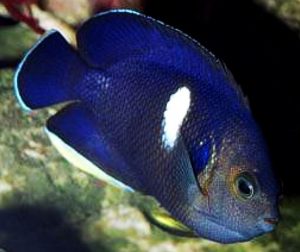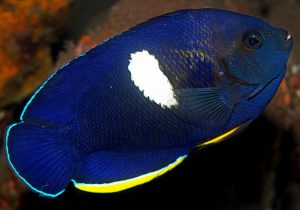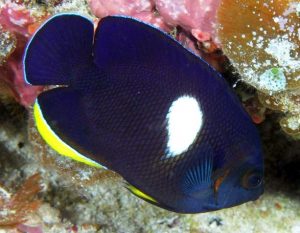Keyhole Angelfish (Centropyge tibicen) known to tropical fish keeping enthusiasts as Black Angelfish, Whitespot Angelfish, Tibicen Angelfish, Melas Angelfish, or Puller Angelfish are found throughout Indo-Pacific waters from the coast of Australia and Christmas Island in the east Indian Ocean to Fiji, east through the Indo-Australian Archipelago to Vanuatu and Tonga, as far north as southern Japan and Taiwan, and south to Scott Reef and Lord Howe Island.
Keyhole Angelfish are found alone and in close groups or harems of 3 to 7 individuals among mixed coral and rubble in the lagoons and seaward reefs of their range at depths from 13 to over 180 feet where they feed on algae, tunicates, filamentous algae, and diatoms.
Keyhole Angelfish have the ability to change sex from female to male. When there is no male is in a harem, the largest, most dominant female in the group normally makes the gender shift.
Keyhole Angelfish have a black to dull brownish blue body color with an elongated, vertical white blotch on the upper middle body that give it its common name. The pelvic and lower portion of the anal fins are yellow, and the dorsal, anal, and caudal fins are edged with a submarginal blue line. Juveniles are mainly black with a white bar that gradually changes into a central blotch that varies greatly in shape and size with age. Female Keyhole Angelfish are usually an overall black color, while the males tend to be more dark blue.
Keyhole Angelfish can be housed in a mature FOWLR or reef aquarium of at least 70 gallon capacity with a crushed coral or live sand substrate and plenty of live rock arranged into crevices, caves, and overhangs for them to graze and hide among. They are not considered reef safe because of their penchant for nipping at stony and soft corals, the mantles of decorative clams, and other sessile invertebrates. They will clean up problem filamentous algae and diatoms in your tank.
Keyhole Angelfish should not be housed in a FOWLR tank with other fish in the same genus, pygmy angels, or fish that are similar in size, shape, or eating behavior. A pair or small harem can be housed in a larger aquarium of 100 gallons or more with plenty of live rock, but two males will fight to the death.
Good tankmates for Melas Angelfish in a large FOWLR tank are dottybacks, 6-line & 8-line wrasse, damselfish, anthias, and clownfish.
Keyhole Angelfish have not been bred in an aquarium environment. They are broadcast spawners that release their eggs and sperm into the water column simultaneously at dusk. After a brief “dance” where the male and female circle each other, the male will swim off the bottom and hover while tilting his body towards the female at a 45 degree angle. If the female is ready to spawn, she will join the male and swim belly to belly towards the surface where they simultaneously release white clouds of sperm filled gametes into the water column for external fertilization.
The planktonic eggs drift with the current on the surface until they hatch into tiny larvae. After hatching, the finless fry live off their yolk sack until it is completely absorbed, at which point they drift down to the bottom of the reef and begin to eat small zooplankton.
In their natural habitat, Melas Angelfish feed mainly on algae and small crustaceans. In an aquarium environment, they need a good amount of algae growing naturally on the live rock in the tank to remain healthy. A quality varied diet of fresh, frozen, or freeze dried meaty and vegetarian foods with marine algae, spirulina, frozen Mysis shrimp, vitamin enriched brine shrimp, and meaty crustaceans such as shaved shrimp or clams fed 2 to 3 times a day will keep them healthy and disease free. Sea Veggies
, Seaweed Salad, and Ocean Nutrition are all easy to use products that will keep them healthy.
Keyhole Angelfish (Centropyge tibicen) are usually available online and in tropical fish stores at approximate purchase sizes of: Small: 1″ to 1-3/4″; Medium: 1-3/4″ to 2-1/2″; Large: 2-1/2″ to 4-1/2″; XLarge: 4-1/2″ and Larger. Prices start at around $89.99 for large specimens from Indonesia.
Minimum Tank Size: 70 gallons
Aquarium Type: FOWLR
Care Level: Moderate
Temperament: Semi Aggressive
Aquarium Hardiness: Hardy
Water Conditions: 72-78° F, dKH 8-12, pH 8.1-8.4, sg 1.020-1.025
Max. Size: 8″
Color Form: Black, Blue, Yellow
Diet: Omnivore
Compatibility: Reef Ok with Caution
Origin: Indo-Pacific
Family: Pomacanthidae
Lifespan: Up to 10 years
Aquarist Experience Level: Intermediate




